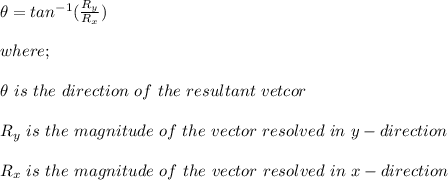
The angle of the resultant vector is equal to
the inverse tangent of the quotient of the x-component divided by the y-component of the resultant vector
the inverse cosine of the quotient of the y-component divided by the x-component of the resultant vector.
the inverse cosine of the quotient of the x-component divided by the y-component of the resultant vector.
the inverse tangent of the quotient of the y-component divided by the x-component of the resultant vector.

Answers: 2


Another question on Physics

Physics, 21.06.2019 20:50
An airplane flies eastward and always accelerates at a constant rate. at one position along its path it has a velocity of 34.3 m/s, it then flies a further distance of 40100 m and afterwards its velocity is 47.5 m/s. find the airplane\'s acceleration and calculate how much time elapses while the airplane covers those 40100 m.
Answers: 1

Physics, 22.06.2019 08:40
Apulley system is used to lift a 2,000 newton engine up a distance of 3 meters. the operator must apply a force of 250 newtons to the chain of the pulley system to lift the motor. to lift the engine 3 meters, the operator must pull a total of 30 meters of chain through the pulley system. what is the value of di?
Answers: 1

Physics, 22.06.2019 09:10
The diagram shows a series of volcanic island and a hot spot determine the direction of movement of the tectonic plate that for the island
Answers: 1

You know the right answer?
The angle of the resultant vector is equal to
the inverse tangent of the quotient of the x-componen...
Questions

Mathematics, 15.01.2020 18:31

Mathematics, 15.01.2020 18:31






Mathematics, 15.01.2020 18:31



Mathematics, 15.01.2020 18:31

English, 15.01.2020 18:31




Mathematics, 15.01.2020 18:31



English, 15.01.2020 18:31




